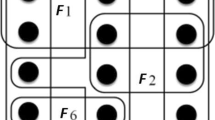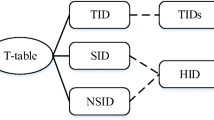Abstract
Sensor data that is often collected in the Internet of Things (IoT) or any smart city environment should be protected against security and privacy concerns. Often, sensor data that is shared by devices in smart cities contains sensitive or private information that can often be shared over different networks and by different smart applications. In the last decade, the area of Privacy-Preserving Data Mining (PPDM) has received a lot of attention as the amount of data received and collected daily is huge. Unfortunately, PPDM mostly applies to binary data. To improve the usefulness of PPDM, we present a more usable version for smart cities called Privacy-Preserving Utility Mining (PPUM), in the form of a Maximal Sensitive Utility-Maximal Sensitive ConflIct (MSU-MSI) algorithm. MSU-MSI finds any conflicting items that may contain sensitive itemsets with high-utility and sanitizes them, stripping them of sensitive and private information while maintaining utility. Any transactions encountered that contain sensitive itemsets are first fed through sanitization processes. This is followed by calculating the total number of items that conflict, and then removing them so sanitization processes can operate more efficiently so as to not redo known sanitization processes. We conduct an in-depth experimental analysis, where our detailed methodology is compared directly with state-of-the-art frameworks such as MSU-MIU, MSU-MAU, HHUIF and MSCIF. Our proposed MSU-MSI shows a higher performance in missing cost, in particular when dealing with highly dense or highly sparse datasets. Moreover, our novel framework is shown to achieve an excellent performance with regards to similarity in database structure and database utility.







Similar content being viewed by others
Data Availability
Data available on request from the authors.
Code Availability
Code available on request from the authors.
References
Agrawal, R., Srikant, R., et al.: Fast algorithms for mining association rules. In: The International Conference on Very Large Data Bases, vol. 1215, pp. 487–499 (1994)
Alawneh, L., Shehab, M.A., Al-Ayyoub, M., Jararweh, Y., Al-Sharif, Z.A.: A scalable multiple pairwise protein sequence alignment acceleration using hybrid CPU-GPU approach. Clust. Comput. 23, 2677–2688 (2020)
Amiri, A.: Dare to share: protecting sensitive knowledge with data sanitization. Decis. Support Syst. 43(1), 181–191 (2007)
Bertino, E., Fovino, I.N., Provenza, L.P.: A framework for evaluating privacy preserving data mining algorithms. Data Min. Knowl. Disc. 11(2), 121–154 (2005)
Cai, H., Xu, B., Jiang, L., Vasilakos, A.V.: Iot-based big data storage systems in cloud computing: perspectives and challenges. IEEE Internet Things J. 4(1), 75–87 (2016)
Chan, R., Yang, Q., Shen, Y.D.: Mining high utility itemsets. In: Third IEEE International Conference on Data Mining, pp. 19–26 (2003)
Chen, M.S., Han, J., Yu, P.S.: Data mining: an overview from a database perspective. IEEE Trans. Knowl. Data Eng. 8(6), 866–883 (1996)
Dasseni, E., Verykios, V.S., Elmagarmid, A.K., Bertino, E.: Hiding association rules by using confidence and support. In: International Workshop on Information Hiding, pp. 369–383 (2001)
Duong, H., Truong, T., Vo, B.: An efficient method for mining frequent itemsets with double constraints. Eng. Appl. Artif. Intell. 27, 148–154 (2014)
Fayyad, U., Piatetsky-Shapiro, G., Smyth, P.: From data mining to knowledge discovery in databases. AI Mag. 17(3), 37–37 (1996)
Gan, W., Lin, J.C.W., Fournier-Viger, P., Chao, H.C., Tseng, V.S., Yu, P.S.: A survey of utility-oriented pattern mining. IEEE Trans. Knowl. Data Eng. 33, 1306–1327 (2019)
Giannotti, F., Lakshmanan, L.V., Monreale, A., Pedreschi, D., Wang, H.: Privacy-preserving mining of association rules from outsourced transaction databases. IEEE Syst. J. 7(3), 385–395 (2012)
Han, J., Pei, J., Yin, Y., Mao, R.: Mining frequent patterns without candidate generation: a frequent-pattern tree approach. Data Min. Knowl. Disc. 8(1), 53–87 (2004)
Hong, T.P., Lin, C.W., Yang, K.T., Wang, S.L.: Using TF-IDF to hide sensitive itemsets. Appl. Intell. 38(4), 502–510 (2013)
Hong, T.P., Wang, C.Y., Tao, Y.H.: A new incremental data mining algorithm using pre-large itemsets. Intell. Data Anal. 5(2), 111–129 (2001)
Jangra, S., Toshniwal, D.: Efficient algorithms for victim item selection in privacy-preserving utility mining. Futur. Gener. Comput. Syst. 128, 219–234 (2022)
Krishnamoorthy, S.: A comparative study of top-k high utility itemset mining methods. In: High-Utility Pattern Mining, pp. 47–74 (2019)
Li, S., Mu, N., Le, J., Liao, X.: A novel algorithm for privacy preserving utility mining based on integer linear programming. Eng. Appl. Artif. Intell. 81, 300–312 (2019)
Li, X., Liu, S., Wu, F., Kumari, S., Rodrigues, J.J.P.C.: Privacy preserving data aggregation scheme for mobile edge computing assisted IoT applications. IEEE Internet Things J. 6(3), 4755–4763 (2019)
Li, X.B., Sarkar, S.: A tree-based data perturbation approach for privacy-preserving data mining. IEEE Trans. Knowl. Data Eng. 18(9), 1278–1283 (2006)
Li, Y.C., Yeh, J.S., Chang, C.C.: MICF: an effective sanitization algorithm for hiding sensitive patterns on data mining. Adv. Eng. Inform. 21(3), 269–280 (2007)
Lin, C.W., Hong, T.P., Wong, J.W., Lan, G.C., Lin, W.Y.: A GA-based approach to hide sensitive high utility itemsets. Sci. World J. 2014 (2014)
Lin, J.C.W., Fournier-Viger, P., Wu, L., Gan, W., Djenouri, Y., Zhang, J.: PPSF: An open-source privacy-preserving and security mining framework. In: IEEE International Conference on Data Mining Workshops, pp. 1459–1463 (2018)
Lin, J.C.W., Liu, Q., Fournier-Viger, P., Hong, T.P., Voznak, M., Zhan, J.: A sanitization approach for hiding sensitive itemsets based on particle swarm optimization. Eng. Appl. Artif. Intell. 53, 1–18 (2016)
Lin, J.C.W., Wu, T.Y., Fournier-Viger, P., Lin, G., Zhan, J., Voznak, M.: Fast algorithms for hiding sensitive high-utility itemsets in privacy-preserving utility mining. Eng. Appl. Artif. Intell. 55, 269–284 (2016)
Lin, M.Y., Tu, T.F., Hsueh, S.C.: High utility pattern mining using the maximal itemset property and lexicographic tree structures. Inf. Sci. 215, 1–14 (2012)
Lindell, Y., Pinkas, B.: Privacy preserving data mining. In: Annual International Cryptology Conference, pp. 36–54 (2000)
Liu, M., Qu, J.: Mining high utility itemsets without candidate generation. In: ACM International Conference on Information and Knowledge Management, pp. 55–64 (2012)
Liu, X., Chen, G., Wen, S., Song, G.: An improved sanitization algorithm in privacy-preserving utility mining. Math. Probl. Eng. 2020, 7489045 (2020)
Liu, X., Wen, S., Zuo, W.: Effective sanitization approaches to protect sensitive knowledge in high-utility itemset mining. Appl. Intell. 50, 169–191 (2020)
Liu, Y., Liao, W.K., Choudhary, A.: A two-phase algorithm for fast discovery of high utility itemsets. In: Pacific-Asia Conference on Knowledge Discovery and Data Mining, pp. 689–695 (2005)
Makani, S., Pittala, R., Alsayed, E., Aloqaily, M., Jararweh, Y.: A survey of blockchain applications in sustainable and smart cities. Clust. Comput. 25(6), 3915–3936 (2022)
Marjani, M., Nasaruddin, F., Gani, A., Karim, A., Hashem, I.A.T., Siddiqa, A., Yaqoob, I.: Big IoT data analytics: Architecture, opportunities, and open research challenges. IEEE Access 5, 5247–5261 (2017)
Sollins, K.R.: IoT big data security and privacy versus innovation. IEEE Internet Things J. 6(2), 1628–1635 (2019)
Sreenivasulu, A.L., Reddy, C.P.: NLDA non-linear regression model for preserving data privacy in wireless sensor networks. Digit. Commun. Netw. 6(1), 101–107 (2020)
Sun, X., Yu, P.S.: A border-based approach for hiding sensitive frequent itemsets. In: IEEE International Conference on Data Mining, p. 8 (2005)
Tseng, L., Yao, X., Otoum, S., Aloqaily, M., Jararweh, Y.: Blockchain-based database in an IoT environment: challenges, opportunities, and analysis. Clust. Comput. 23, 2151–2165 (2020)
Verykios, V.S., Elmagarmid, A.K., Bertino, E., Saygin, Y., Dasseni, E.: Association rule hiding. IEEE Trans. Knowl. Data Eng. 16(4), 434–447 (2004)
Wu, D., Yang, B., Wang, R.: Scalable privacy-preserving big data aggregation mechanism. Digit. Commun. Netw. 2(3), 122–129 (2016)
Wu, J.M.T., Zhan, J., Lin, J.C.W.: Ant colony system sanitization approach to hiding sensitive itemsets. IEEE Access 5, 10024–10039 (2017)
Yao, H., Hamilton, H.J.: Mining itemset utilities from transaction databases. Data Knowl. Eng. 59(3), 603–626 (2006)
Yao, H., Hamilton, H.J., Butz, C.J.: A foundational approach to mining itemset utilities from databases. In: SIAM International Conference on Data Mining, pp. 482–486 (2004)
Yao, X., Farha, F., Li, R., Psychoula, I., Chen, L., Ning, H.: Security and privacy issues of physical objects in the IoT: challenges and opportunities. Digit. Commun. Netw. 7, 373–384 (2020)
Yeh, J.S., Hsu, P.C.: HHUIF and MSICF: novel algorithms for privacy preserving utility mining. Expert Syst. Appl. 37(7), 4779–4786 (2010)
Yun, U., Kim, J.: A fast perturbation algorithm using tree structure for privacy preserving utility mining. Expert Syst. Appl. 42(3), 1149–1165 (2015)
Acknowledgements
This work is partially supported by the Natural Sciences Research Council of Canada (NSERC) through their Discovery Grants program held by Dr. Gautam Srivastava (RGPIN-2020-05363)
Funding
This work is partially supported by the Natural Sciences Research Council of Canada (NSERC) through their Discovery Grants program held by Dr. Gautam Srivastava (RGPIN-2020-05363)
Author information
Authors and Affiliations
Contributions
GS: Conceptualization, Methodology, Software, Data curation, Validation, Investigation, Visualization, Writing - original draft. JC-WL: Supervision, Conceptualization, Methodology, Investigation, Writing - review & editing. GL: Methodology, Validation, Writing - review & editing.
Corresponding author
Ethics declarations
Conflict of interest
The authors have no Conflicts of Interest to declare for this manuscript.
Ethical Approval
For this type of study formal consent was not required. This manuscript does not contain any studies with human participants or animals performed by any of the authors.
Additional information
Publisher's Note
Springer Nature remains neutral with regard to jurisdictional claims in published maps and institutional affiliations.
Rights and permissions
Springer Nature or its licensor (e.g. a society or other partner) holds exclusive rights to this article under a publishing agreement with the author(s) or other rightsholder(s); author self-archiving of the accepted manuscript version of this article is solely governed by the terms of such publishing agreement and applicable law.
About this article
Cite this article
Srivastava, G., Lin, J.CW. & Lin, G. Secure itemset hiding in smart city sensor data. Cluster Comput 27, 1361–1374 (2024). https://doi.org/10.1007/s10586-023-04000-2
Received:
Revised:
Accepted:
Published:
Issue Date:
DOI: https://doi.org/10.1007/s10586-023-04000-2




